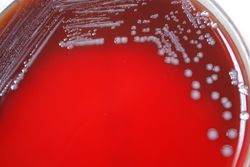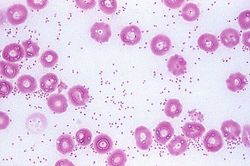Pasturella canis: Difference between revisions
| Line 23: | Line 23: | ||
All of the currently reported <i>P. canis</i> strains are gram-negative, oxidase-positive, nonmotile, fermentative rods.<sup>(7,8)</sup> From laboratory observation and culture, it has been noted that colonies of <i>P. canis</i> are non-acid-fast and bipolar stained. In addition, observable colonies are 1.0-1.5mm in diameter, non-hemolytic, smooth, slightly raised, and grayish-yellow after 24 hours of incubation. Colonies grow at room temperature and at 37°, but not at 4°.<sup>(9, 10)</sup> | All of the currently reported <i>P. canis</i> strains are gram-negative, oxidase-positive, nonmotile, fermentative rods.<sup>(7,8)</sup> From laboratory observation and culture, it has been noted that colonies of <i>P. canis</i> are non-acid-fast and bipolar stained. In addition, observable colonies are 1.0-1.5mm in diameter, non-hemolytic, smooth, slightly raised, and grayish-yellow after 24 hours of incubation. Colonies grow at room temperature and at 37°, but not at 4°.<sup>(9, 10)</sup> | ||
[[Image:pasteurella-canis.JPG|thumb|250px|right|Gram stain of <i>P. canis</i> to illustrate its gram negative property and rod-like morphology. From: [ | [[Image:pasteurella-canis.JPG|thumb|250px|right|Gram stain of <i>P. canis</i> to illustrate its gram negative property and rod-like morphology. From: [https://synapse.koreamed.org/DOIx.php?id=10.3343/alm.2016.36.6.617&vmode=PUBREADER. Pasturella canis]]] | ||
“Micrococcus gallicidus” was the first scientific name used for these bacteria.[4][5] For a short time, the bacteria were unofficially placed in different genera, such as Octopsis, Coccobacillus, and Eucystia. In 1887, genus “Pasteurella” was proposed to honor Louis Pasteur for his critical discoveries in the field of microbiology.[1] | “Micrococcus gallicidus” was the first scientific name used for these bacteria.[4][5] For a short time, the bacteria were unofficially placed in different genera, such as Octopsis, Coccobacillus, and Eucystia. In 1887, genus “Pasteurella” was proposed to honor Louis Pasteur for his critical discoveries in the field of microbiology.[1] | ||
Revision as of 17:34, 25 February 2017
Classification
Phylum: Proteobacteria
Class: Gammaproteobacteria
Order: Pasteurellales
Genus: Pasteurella
Species: Pasteurella canis
|
NCBI: Taxonomy |

Description and significance
Pasteurella canis, from Latin, canis ("dog") is a group of bacterial strains which are isolated from the oral and respiratory tracts of a wide variety of animals, including dogs, cats, rabbits, horses, sheep, cattle, ferrets, deer, and even california sea lions!(1-6) All of the currently reported P. canis strains are gram-negative, oxidase-positive, nonmotile, fermentative rods.(7,8) From laboratory observation and culture, it has been noted that colonies of P. canis are non-acid-fast and bipolar stained. In addition, observable colonies are 1.0-1.5mm in diameter, non-hemolytic, smooth, slightly raised, and grayish-yellow after 24 hours of incubation. Colonies grow at room temperature and at 37°, but not at 4°.(9, 10)

“Micrococcus gallicidus” was the first scientific name used for these bacteria.[4][5] For a short time, the bacteria were unofficially placed in different genera, such as Octopsis, Coccobacillus, and Eucystia. In 1887, genus “Pasteurella” was proposed to honor Louis Pasteur for his critical discoveries in the field of microbiology.[1]
Before molecular technology was available, species were often labeled based on staining and the hosts from where species were isolated.[1] The name "multocida" was ultimately adopted to represent all the Pasteurella species.[1][6] Until 1932, the genus Pasteurella only consisted of the species type Pasteurella multocida.[6] Pasteurella canis sp. nov. was previously classified as P. multocida biotype 6 or “dog-type” strains. In 1985, Pasteurella underwent taxonomic reclassification based on DNA hybridization, resulting in several subspecies of P. multocida and new Pasteurella species, including P. canis.[1]
P. canis includes two biotypes: biovar 1 originated from canines, whereas biovar 2 originated from bovines. The two biotypes are distinguishable from an indole test: biovar 1 is indole positive whereas biovar 2 is indole negative.[1]
Strains are V-factor independent. They are positive for the ornithine decarboxylation test, and negative for acid production from L-arabinose, raffinose, D-lactose, maltose, mannitol, sorbitol, or dulcitol. The urease test is also negative; variable reactions are obtained for acid production from trehalose and D-xylose. There are 2 biotypes: Biotype 1 strains exhibit positive reactions for indole, biotype 2 strains exhibit negative reactions for indole. P. canis biotype 1 is found in the oral cavities of dogs and is often isolated from injuries in humans resulting from dog bites. Biotype 2 strains have been isolated from calves. They have been isolated from wound sites after dog/cat bite and synovial fluid.
Genome and genetics
a. To what major branch of the prokaryotes do they belong? (see textbook or Bergey’s). List 2-3 closely related but separate species or genera of bacteria. b. Briefly describe any extra-chromosomal elements or genetic tools that are used to study the bacterium: viruses, plasmids, transposons that allow genetic manipulation and analysis. c. Has the genome or genomes been sequenced? If so, include the website for the database and one or two highlights of the genome. Also indicate genome size (base pairs), %G+C (nucleotide base composition) and number of genes, and specific genes or gene regions that are unique to this organism. If it has not been sequenced, give its closest relative that has been sequenced, its website, and some general information about the related sequence.
Example: The sequence of Haemophilus influenzae was determined using whole genome shotgun sequencing (Fleischmann et al. 1995).
Nutrition and metabolism
a.Describe the growth characteristics of your bacterial species; sources of C, N, electrons; respires/ferments, uses O2, etc. b.What kinds of culture conditions (temp, pH, media) are needed for laboratory study? c.What kinds of waste, by-products, volatile compounds are generated?
Ecology / Pathology
Ecology: How is your microorganism important in the ecosystem where it is found? How does it impact other organisms in the environment (could be positive or negative impact)? Pathology: How does the microbe cause disease as it interacts with the host? Describe any specific toxins or pathways that are used for invading and causing disease in the host. What treatment is used to inhibit or kill the microbe?
Current Research
Describe recent research and findings that have been done with this organism. The research can be clinical, applied or basic research. This section should be based on 2 recent papers (10 years or less) and summarized in your own words. References
The format for citations and for the “References” list will follow the “Citation—Name” Council of Science Editors (CSE) format, as the suggested formatting method listed on the MicrobeWiki Home page. The reference list will be numbered based on an alphabetical list of the first author’s last name. A style guide for the CSE format can be found here: http://writing.wisc.edu/Handbook/DocCSE_CitationSystems.html.
For an example, see this entry: https://microbewiki.kenyon.edu/index.php/Bacillus_anthracis
References
(1) Haraa, Hiroyuki, et al. "Pasteurella canis osteomyelitis and cutaneous abscess after a domestic dog bite." Journal of the American Academy of Dermatology 46.5 (2002): S151-S152.
(2) Biberstein, Ernst L., et al. "Distribution of indole-producing urease-negative pasteurellas in animals." Journal of Veterinary Diagnostic Investigation 3.4 (1991): 319-323.
(3) Bourgault, Andree, Rianatou Bada, and Serge Messier. "Isolation of Pasteurella canis from a foal with polyarthritis." The Canadian Veterinary Journal 35.4 (1994): 244.
(4) Hansen, Mie Johanne, et al. "Occurrence of Pasteurellaceae bacteria in the oral cavity of selected marine mammal species." Journal of Zoo and Wildlife Medicine 43.4 (2012): 828-835.
(5) Sarkozi, R., L. Makrai, and L. Fodor. "Characterization of Pasteurella species isolated from oral cavity of cats." Magyar Allatorvosok Lapja 133.9 (2011): 540-545.
(6) Yefet, E., et al. "Unusual infection--Pasteurella canis bacteremia in a child after exposure to rabbit secretions." Harefuah 150.1 (2011): 13-5.
(7) Albert, T. J., and Dennis L. Stevens. "The first case of Pasteurella canis bacteremia: a cirrhotic patient with an open leg wound." Infection 38.6 (2010): 483-485.
(8) Rashid, Noor-Khairul, et al. "Pasteurella canis isolation following penetrating eye injury: a case report." Case reports in ophthalmological medicine 2012 (2012).
(9) Christensen, Henrik, et al. "Revised description and classification of atypical isolates of Pasteurella multocida from bovine lungs based on genotypic characterization to include variants previously classified as biovar 2 of Pasteurella canis and Pasteurella avium." Microbiology 150.6 (2004): 1757-1767.
(10) Figure out how to cite Bergey
Authored by Joshua Place, a student of CJ Funk at John Brown University
